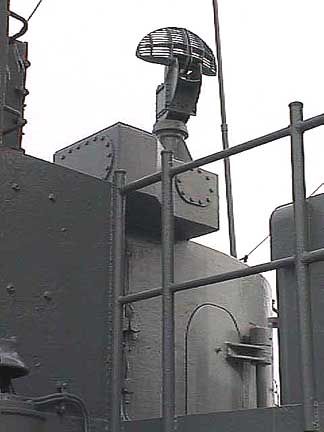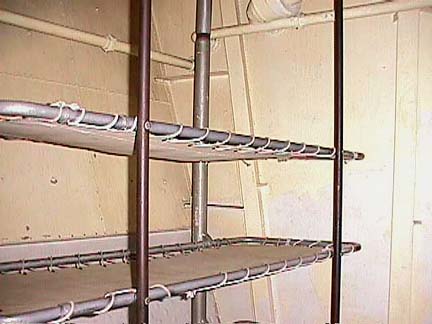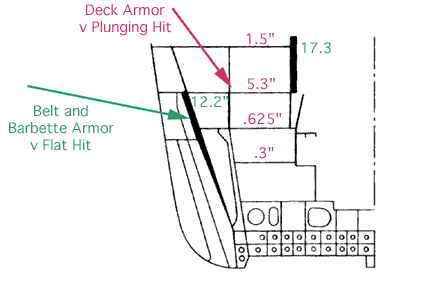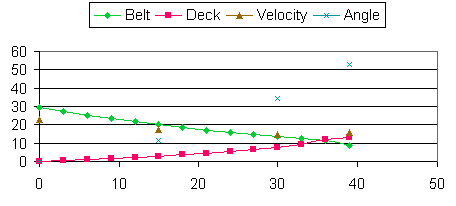 |
 |
 |
|
|
On my prior trip to the Massachusetts, as noted on the perspectives page, I had found few photo angles which show the thickness of the armor. On my last trip, I went deliberately hunting for armor. I did find another door into the conning tower, up a level from the bridge. This one is closed, but shows the same construction as on the Perspectives page. Note the oval shape of the conning tower. Unless a shell hits towards the center of the tower, it is apt to hit the armor at a strong angle, giving a glancing rather than a solid blow.
 |
|
|
I suspect the others aboard thought me nuts. I'd quickly run by the butcher's shop, the master at arm's room, the barber shop, give a quick look, move on, only to stop and take pictures of an empty room. It is, of course, not quite empty. The large duct to the left carries ammo up to a five inch mount above. There are pipes. (A lot of rooms have pipes.) There are bunks. (The captain's office, described as the administrative center of the ship, has bunks.) Of interest, however, is the wall to the right.
Remember how the conning tower was oval to increase the chance that a shell would glance off? The Massachusetts was designed with an angled internal armor scheme. The main armor belt was tilted at a 19 degree angle. Note the 19 degree angle between the vertical pipes supporting the bunks, and the walls to the right. The bunks are at a juncture where a support bulkhead meets the main armor belt.
 |
|
|
 |
|
|
In red, above, is a plunging shot, the result of an attack lobbed in from long range. In green is a shorter range attack, coming in at a shallower angle but at higher speed. An attack hitting armor straight on has more penetrating power. Thus, armor is more effective when positioned at an angle to likely attacks. Deck armor can be thinner but still effective as plunging shots hit it at an angle, not straight down, and plunging shots are not moving quite as fast. The Massachusetts' side armor was positioned at an angle so incoming shells would be more apt to bounce downwards than penetrate.
Massachusetts' own guns had penetrating power against vertical and horizontal armor as follows. Range is in thousands of yards. The angle is in degrees below horizontal. Velocity is in hundreds of feet per second. The amount of vertical and horizontal armor penetrated is in inches.
|
|
|
|
|
|
|
|
|
|
|
|
|
|
|
|
|
|
|
|
|
|
|
|
|
|
|
|
|
|
|
|
|
|
|
|
|
|
|
|
|
|
|
|
|
|
|
|
|
|
|
|
|
|
|
|
|
|
|
|
|
|
|
|
|
|
|
|
|
|
|
|
|
|
|
|
|
|
|
|
 |
|
|
Remember the 16 inches of armor at the conning tower? Against an opponent with equally powerful guns, if Massachusetts was 20,500 yards away or more, incoming shells could not penetrate. The deck armor is 5.5 inches thick. If the opponent was closer than 26,400 yards, the deck armor should hold from a plunging shot. Between these distances, from 20,500 to 26,400 yards, is the "immune zone." Within that belt, Massachusetts was in theory protected from hits to her vital areas.
US battleships were designed with state of the art guns, and armor to have a significant "immune zone" them from their own guns. When designed, Massachusetts' guns were to fire 2240 pound shells, and the immune zone was 18,000 to 30,000 yards. The ordinance departments developed heavier shells and more potent guns while Massachusetts armor remained as built. Against an Iowa or Yamato, the Massachusetts would have to depend on the skill of her gunners rather than theoretical immunity.
The differences in thickness of the decks was also a trade off. On Massachusetts, the main deck was thick enough to trigger the fuse mechanism, the second was intended to stop the shell, the third was a "splinter deck," thick enough to stop shrapnel, but not protect from a penetrating shot. Another factor in armoring decks is the center of gravity of the ship. Weight high up in a ship made it unstable, prone to capsizing. This is another factor in choosing to armor the second deck, rather then the first.
 |
|
|
Down one deck from the empty room was a storage area. This room is near water level, where torpedoes become more of a problem than shells. The torpedo defense was multi layered: an open space, a tank full of fluid (water or fuel oil), than another open space. This is the inner open space. While the armor gets thinner below the water level, it is braced by numerous supports. While the supports are angled at a strong angle, roughly 30 degrees, the wall being braced is a continuation of the armor belt, still angled at 19 degrees.
 |
Shore - Dock -
Engines - Dry-dock
- Perspectives
Anchor - 16 Inch -
George - Turret 3
- Shells - Magazines
- Jean Bart - Armor
Hatches - Five
Inchers - Inside 5" - Quad
40s - Turkey Trot
AA Directors - Sky -
Spot - Radar -
Last Look - History
- BB Names
Massachusetts - Galveston
- Homepage - NavShips
& NavRing